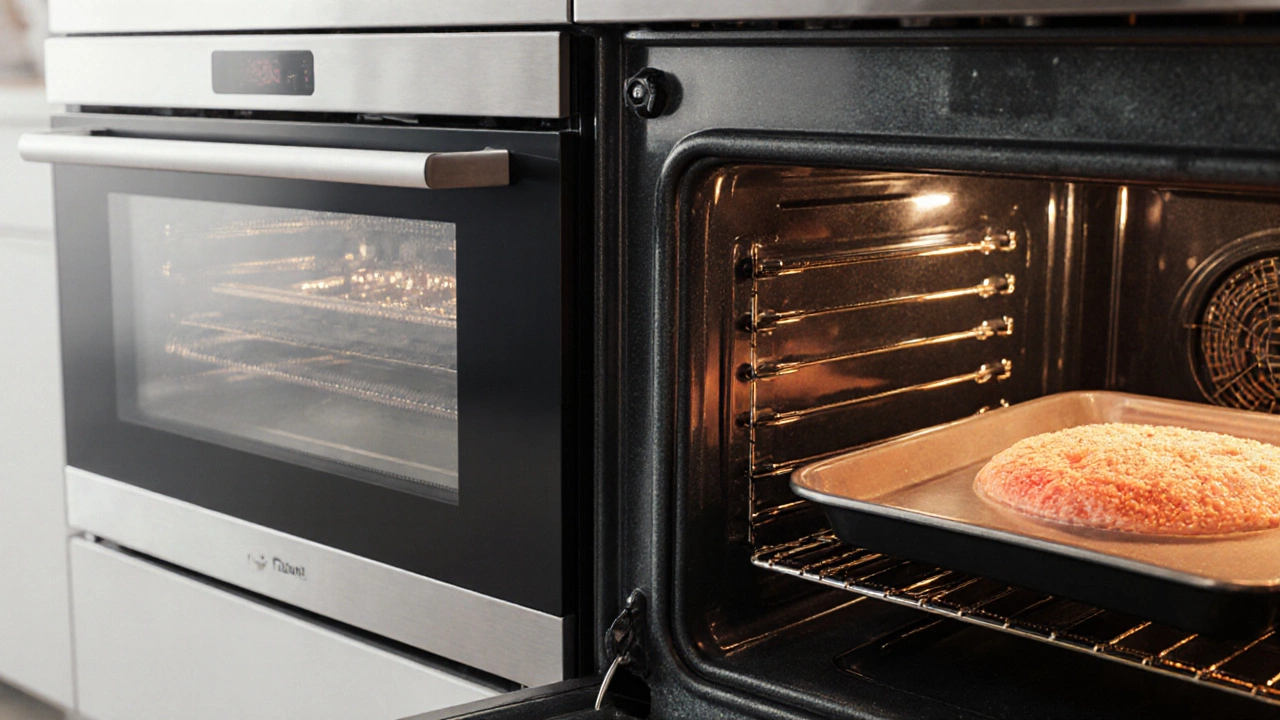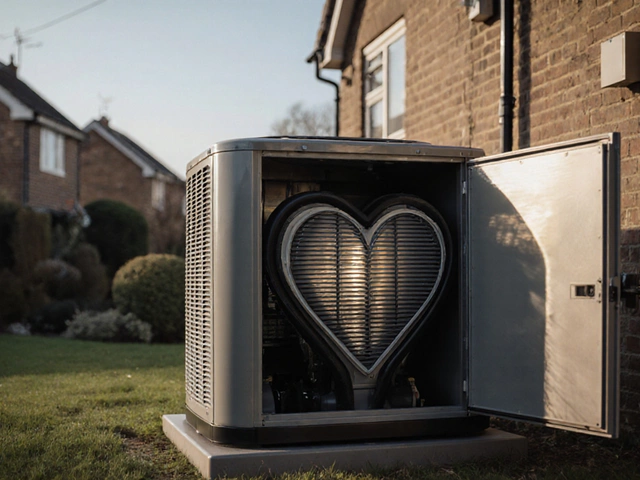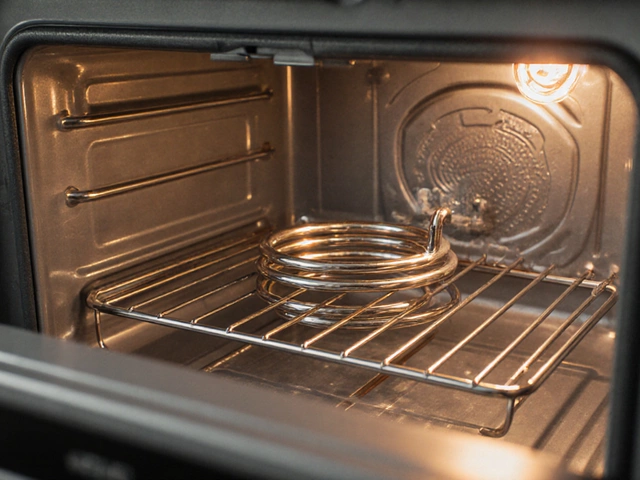If your electric oven isn’t heating up, takes forever to preheat, or cooks food unevenly, it’s not just being stubborn-it’s giving you clues. Most people assume a broken oven means a costly replacement, but often, it’s a simple part that’s failed. Knowing how to spot the signs early can save you time, money, and a lot of frustration.
Is the oven completely dead?
First, check if the oven turns on at all. If the display is blank and the interior light doesn’t come on when you open the door, the issue might not be the oven itself. Start with the basics: is the circuit breaker tripped? In New Zealand, many electric ovens run on a dedicated 240V circuit. Go to your switchboard and look for a breaker labeled "Oven" or "Cooktop". If it’s flipped to the off position, reset it. If it trips again right away, don’t keep resetting it-that’s a sign of a serious wiring fault or short circuit. Call a licensed electrician.
If the breaker is fine but the oven still shows no power, check the plug. Some built-in ovens have a hidden power switch behind the kickplate or near the bottom front. Make sure it’s turned on. Also, verify that the oven isn’t in a timed cooking or self-clean mode that’s locked out the controls.
The oven won’t heat up, but the light and fan work
This is the most common electric oven problem. If the interior light turns on and the fan spins, but the oven stays cold, the heating elements are likely the culprit. There are two main elements: the bake element (bottom) and the broil element (top). The bake element does most of the work during normal cooking.
To check the bake element, turn the oven on to 180°C and watch through the door. If the bottom element stays black and doesn’t glow red, it’s probably blown. A healthy element will glow bright orange-red within a few minutes. You might also see visible damage-bubbling, cracks, or sections that are burnt out. Even if it looks okay, the element could still be faulty. You can test it with a multimeter for continuity, but if you’re not comfortable with electrical tools, skip the test and just replace it. Bake elements are cheap, usually under $60 NZD, and easy to swap.
The broil element is less likely to fail, but if you’re using broil mode and nothing happens, that’s your next suspect. It’s usually mounted on the ceiling of the oven cavity and can be inspected the same way.
Food cooks unevenly or burns on one side
If your oven heats but food comes out undercooked on one side and burnt on the other, the problem is airflow or element performance. First, make sure you’re not blocking the oven vents with pans or foil. Many people line the bottom with aluminum foil to catch spills-this traps heat and disrupts circulation. Remove it.
If the vents are clear, the issue might be a failing bake element. Even if it glows, it might not be producing full heat. A weak element will take longer to heat up and won’t maintain temperature evenly. You might notice the oven cycling on and off too often, or the temperature fluctuates more than it should.
Another possibility is a faulty thermostat or temperature sensor. The sensor is a thin metal probe, usually located on the back wall of the oven. If it’s dirty, bent, or damaged, it sends wrong signals to the control board. Wipe it gently with a damp cloth. If it’s broken, the oven might think it’s hotter than it is and shut off early-or think it’s cold and overheat.

The oven overheats or won’t turn off
Overheating is dangerous and often caused by a stuck relay on the control board or a failed thermostat. If your oven keeps running even after you’ve turned it off, or the temperature climbs way past what you set (say, 250°C when you set 180°C), stop using it immediately. Unplug the oven or turn off the circuit breaker.
A faulty thermostat is the most common cause. It’s not always visible from the outside. In older ovens, it’s a mechanical dial with a bulb sensor. In newer models, it’s a digital sensor connected to the control board. If you’ve ruled out the sensor being dirty or bent, the control board might be misreading the signal. This is harder to fix without tools, and replacement boards can cost $150-$300 NZD. In many cases, it’s cheaper to replace the whole oven unless it’s a high-end model.
Strange smells or smoke when using the oven
A little odor when you first turn on a new oven-or after a deep clean-is normal. But if you smell burning plastic, electrical smoke, or a metallic scent, that’s not normal. It could mean:
- A wire inside the oven has melted or frayed
- The insulation around a heating element is burning
- Food residue has built up over years and is now carbonizing
Start by cleaning the oven thoroughly. Use a non-abrasive cleaner and remove the racks. If the smell persists after cleaning, don’t use the oven again until you’ve checked the internal wiring. A professional should inspect it-electrical fires from ovens are a real risk, especially in older homes with outdated wiring.
The oven light works, but the display is blank
If the oven has a digital display that’s dead but the light turns on, the problem is likely with the control board or the power supply to the display. This can happen after a power surge or if moisture got inside the control panel. Try resetting the oven by turning off the circuit breaker for 10 minutes. If that doesn’t fix it, the control board may need replacing. These boards are sensitive and often not worth repairing unless the oven is less than five years old.

When to call a professional
You can safely check the elements, clean the sensor, and reset the breaker yourself. But if you’re dealing with:
- Tripping breakers that won’t stay on
- Smoke, burning smells, or melted plastic
- Dead display with no power to controls
- Any signs of damaged wiring behind the oven
-then call a qualified appliance technician. Electric ovens carry 240 volts. Even when unplugged, capacitors inside the control panel can hold a charge. DIY repairs on these parts can be deadly if you’re not trained.
Most repair technicians in Auckland charge $80-$120 NZD for a service call, and they’ll diagnose the issue within 15 minutes. If the fix is under $200, it’s usually worth it. If the oven is over 10 years old and needs a control board or major part, consider replacement. Modern ovens are more energy-efficient and come with better safety features.
Quick checklist: What to check first
- Is the circuit breaker tripped? Reset it.
- Is the oven’s power switch (if present) turned on?
- Does the bake element glow red when heated?
- Is the temperature sensor clean and straight?
- Is there food debris or foil blocking airflow?
- Do you smell burning or see smoke?
- Is the display completely dead, or just frozen?
If you answered "no" to the glow or "yes" to burning smells, don’t guess-call someone. If everything looks fine but the oven still doesn’t work, the problem is likely internal and needs a pro.
Preventing future problems
Regular maintenance stops most oven failures:
- Clean spills right away-don’t let them bake on
- Don’t line the bottom with foil
- Wipe the temperature sensor every few months
- Check the door seal-if it’s cracked or loose, heat escapes and the oven works harder
- Use the self-clean function sparingly-it stresses the elements and insulation
Most electric ovens last 10-15 years. If yours is nearing that age and you’re fixing it every year, it’s time to think about upgrading. Newer models use less energy, heat more evenly, and have better safety cut-offs.





